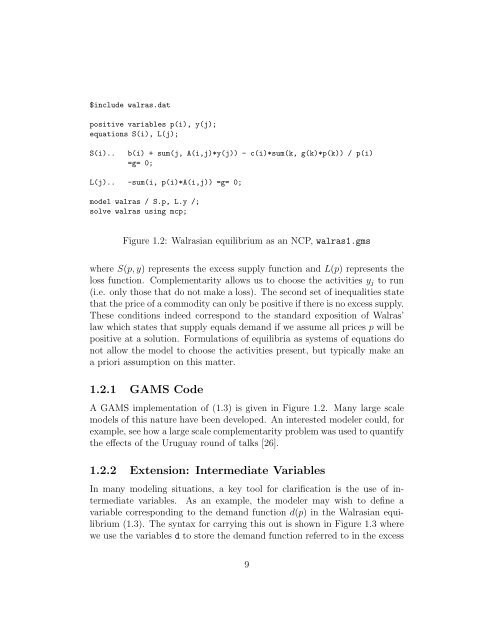GAMS/PATH User Guide Version 4.3
GAMS/PATH User Guide Version 4.3
GAMS/PATH User Guide Version 4.3
Create successful ePaper yourself
Turn your PDF publications into a flip-book with our unique Google optimized e-Paper software.
$include walras.dat<br />
positive variables p(i), y(j);<br />
equations S(i), L(j);<br />
S(i).. b(i) + sum(j, A(i,j)*y(j)) - c(i)*sum(k, g(k)*p(k)) / p(i)<br />
=g= 0;<br />
L(j).. -sum(i, p(i)*A(i,j)) =g= 0;<br />
model walras / S.p, L.y /;<br />
solve walras using mcp;<br />
Figure 1.2: Walrasian equilibrium as an NCP, walras1.gms<br />
where S(p, y) represents the excess supply function and L(p) representsthe<br />
loss function. Complementarity allows us to choose the activities yj to run<br />
(i.e. only those that do not make a loss). The second set of inequalities state<br />
that the price of a commodity can only be positive if there is no excess supply.<br />
These conditions indeed correspond to the standard exposition of Walras’<br />
law which states that supply equals demand if we assume all prices p will be<br />
positive at a solution. Formulations of equilibria as systems of equations do<br />
not allow the model to choose the activities present, but typically make an<br />
a priori assumption on this matter.<br />
1.2.1 <strong>GAMS</strong> Code<br />
A <strong>GAMS</strong> implementation of (1.3) is given in Figure 1.2. Many large scale<br />
models of this nature have been developed. An interested modeler could, for<br />
example, see how a large scale complementarity problem was used to quantify<br />
the effects of the Uruguay round of talks [26].<br />
1.2.2 Extension: Intermediate Variables<br />
In many modeling situations, a key tool for clarification is the use of intermediate<br />
variables. As an example, the modeler may wish to define a<br />
variable corresponding to the demand function d(p) in the Walrasian equilibrium<br />
(1.3). The syntax for carrying this out is shown in Figure 1.3 where<br />
we use the variables d to store the demand function referred to in the excess<br />
9

















